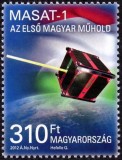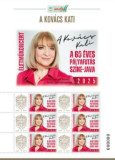
1. MAGYAR - Alkalmi bélyeg a Masat-1, az első magyar műhold tiszteletére - Bélyeg rendelési kód: 2012 év bélyegei kompletten
2. ENGLISH - MASAT 1 - Order code of the stamp: 2012 Year stamps complete
3. GERMAN - MASAT 1 - Die Bestellnummer Der Marke: 2012 Jahr Briefmarken komplett
1. MAGYAR - Alkalmi bélyeg a Masat-1, az első magyar műhold tiszteletére
A Magyar Posta az első magyar mesterséges égitest, a Masat-1 sikeres pályára állása alkalmából bélyeget bocsát ki. Az alkalmi bélyeg, a hozzátartozó boríték és bélyegző Hefelle Glória grafikusművész alkotása. Az újdonság az Állami Nyomdában készült 250.000 példányban. A bélyeg ünnepélyes keretek között jelenik meg 2012. április 12-én a Budapesti Műszaki és Gazdaságtudományi Egyetemen tartott szakmai fórum keretében. A bélyegkép főmotívuma a Masat-1, melynek hátterében a Föld és a magyar nemzeti zászló látható. A tervek szerint a bélyegkibocsátás időpontjában a magyar műholdról különleges üzenetet vehetnek majd a rádióamatőrök.
A Masat-1 MO–72 az első teljesen magyar építésű mesterséges égitest, melyet magyar idő szerint 2012. február 13-án 11 órakor indították útnak, a Francia Guyana-i Kourou melletti űrközpontból.
A CubeSat szabványt a California Polytechnic State University és a San Luis Obispo and Stanford University's Space Systems Development Lab dolgozta ki. Célja, hogy a bekapcsolódó egyetemek 10×10×10 cm méretű, legfeljebb 1 kg tömegű egységekben meghatározott, működő pikoműholdat fejlesszenek ki.
A Budapesti Műszaki és Gazdaságtudományi Egyetem (BME) hallgatói 2006-ban látták meg a würzburgi egyetem által kifejlesztett pikoműholdat, majd 2007-ben, oktatók és kutatók támogatásával, Dr. Gschwindt András vezetésével megalakult a Masat-1 Fejlesztői Csapat.
Elhatározták, hogy a szabvány alapján létrehozzák hazánk első műholdját. A csoport tagjai: Bükkfejes András, Czifra Dávid, Dudás Levente, Glisics Sándor, Horváth Gyula, Hödl Emil, Kovács Zoltán, Marosy Gábor, Mezei Tibor, Temesvölgyi Tamás, Varga Lajos és Várhegyi Zsolt. Céljuk az volt, hogy olyan szerkezetet hozzanak létre, mely képes túlélni a felbocsátáskori rázkódást, alkalmazkodik a szélsőséges környezethez, a Földtől 300-1450 km magasságban legalább 3 hónapig képes működni és folyamatosan kommunikálni a földi vezérlőállomással.
Az utolsó pillanatban még egy kis tömegű kamera is bekerülhetett a műholdba. Az első sikeres képek a Földről a 2012. március eleji napvihart követően készültek. A 300 millió forintos eszmei értékű projekt megvalósításába az egyetem Villamosmérnöki és Informatikai Karának két tanszéke – az Elektronikus Eszközök Tanszék, a Szélessávú Hírközlés és Villamosságtan Tanszék és annak Űrkutató Csoportja, valamint számos külső cég is bekapcsolódott.
A Masat-1 kifejlesztése megközelítőleg 56.000 mérnökórát vett igénybe. A rádió a 70 centiméteres amatőr sávon működik, így bármely rádióamatőr veheti a telemetriai adatokat a pálya ismeretében, a műhold honlapjáról letölthető dekódoló szoftver segítségével. (Forrás: cubesat.bme.hu)
A Magyar Posta legújabb bélyegének ünnepélyes kibocsátásával egy időben a Magyar Nemzeti Bank is bemutatja numizmatikai újdonságát, mely ugyancsak az első magyar műhold pályára állása alkalmára született. A bélyeg és az érme kibocsátás időpontjában a műholdról a MASAT-1 onSTAMP&COIN üzenetet vehetik majd a rádióamatőrök.
Forrás: Posta
2. ENGLISH - MASAT 1
Special stamp in honour of the first Hungarian satellite, Masat 1
Magyar Posta is issuing a stamp to mark successfully putting Masat 1, the first Hungarian satellite, into orbit. The stamp, its first day cover and the cancellation mark were designed by the graphic artist Glória Hefelle. 250,000 copies of the new stamp have been made by the state printing company Állami Nyomda. The stamp is to be released on 12 April 2012 at a ceremony at a professional forum held at the Budapest University of Technology and Economics. The main motif of the stamp is Masat 1, which is set against a background of the earth and the Hungarian national flag. It is planned that a special message will be sent to radio amateurs from the Hungarian satellite at the time the stamp is issued.
Masat 1 MO–72 is the first entirely Hungarian built satellite, which was launched from the space centre near Kourou in French Guiana at 11 am on 13 February 2012 Hungarian time. The CubeSat standard was devised by California Polytechnic State University, San Luis Obispo, and Stanford University's Space Systems Development Lab. The CubeSat project’s aim was to enable the universities involved to perform space science using picosatellites, units of 10×10×10 cm, weighing no more than 1 kg. Students at the Budapest University of Technology and Economics saw a picosatellite developed by the University of Würzburg in 2006, and in 2007 the Masat 1 Development Team, headed by Dr. András Gschwindt, was set up with the backing of teachers and researchers. They decided to build Hungary’s first satellite using this standard. The members of the team are András Bükkfejes, Dávid Czifra, Levente Dudás, Sándor Glisics, Gyula Horváth, Emil Hödl, Zoltán Kovács, Gábor Marosy, Tibor Mezei, Tamás Temesvölgyi, Lajos Varga and Zsolt Várhegyi.
Their goal was to create a device that would be able to survive the juddering during launch and could function in the extreme environment 300 to 1,450 km from the earth for at least 3 months, communicating continuously with its ground control station. At the last moment a lightweight camera was installed in the satellite. The first successful pictures of the earth were taken after the solar storm in early March 2012. Two departments of the Budapest University’s Faculty of Electrical Engineering and Informatics (the Department of Electronic Devices and the Department of Broadband Infocommunications and Electronic Theory with its Space Research Team) as well as numerous external companies collaborated in the implementation of the project, which has an intellectual value of HUF 300 million. Masat 1 took approximately 56,000 engineering hours to develop. The radio operates in the 70 centimetre amateur band, thus any radio amateur can receive telemetric data in the knowledge of its orbit and using decoding software downloaded from the satellite’s web site. (Source: cubesat.bme.hu)
At the same time as the ceremony issuing Magyar Posta’s latest stamp, Hungary’s central bank, Magyar Nemzeti Bank, will present a numismatic novelty, which likewise commemorates the first Hungarian satellite being put into orbit. At the time of the release of the stamp and the coin, radio amateurs can receive the MASAT-1 onSTAMP&COIN message from the satellite.
3. GERMAN - MASAT 1
Sonderbriefmarke zu Ehren des ersten ungarischen Satelliten Masat-1
Die Magyar Posta gibt zu Ehren des erfolgreichen Einschießens des ersten ungarischen künstlichen Erdsatelliten Masat-1 in die Umlaufbahn eine Briefmarke heraus. Die Sonderbriefmarke, der Umschlag und der Stempel sind Werke der Grafikerin Glória Hefelle. Die Novität wurde in 250.000 Exemplaren in der Állami Nyomda (Staatsdruckerei) hergestellt. Die Briefmarke erscheint am 12. April 2012 in feierlichem Rahmen auf dem Berufsforum der Technischen und Wirtschaftswissenschaftlichen Universität Budapest. Das Hauptmotiv der Briefmarke ist der Satellit Masat-1 mit der Erde und der ungarischen Nationalflagge im Hintergrund. Die Funkamateure werden am Tag der Briefmarkenausgabe von dem ungarischen Satelliten voraussichtlich eine besondere Botschaft empfangen können.
Der Masat-1 MO–72 ist der erste – vollständig von ungarischen Experten erbaute – künstliche Erdsatellit, der von dem Raketenstartplatz Kourou im französischen Überseedepartement Französisch-Guayana am 13. Februar 2012 um 11:00 Uhr ungarischer Zeit in seine Umlaufbahn gebracht wurde. Der Standard CubeSat ist ein von der California Polytechnic State University und der San Luis Obispo and Stanford University's Space Systems Development Lab initiiertes internationales Programm, das es Universitäten und Hochschulen ermöglicht, Picosatelliten in eine Umlaufbahn zu bringen. Diese Satelliten müssen einem standardisierten Format entsprechen, wobei Abmessungen von 10 cm ×10 cm ×10 cm und ein Gewicht von maximal 1 kg einzuhalten sind. 2006 hatten die Studenten der Technischen und Wirtschaftswissenschaftlichen Universität Budapest (BME) den von der Universität Würzburg entwickelten Picosatelliten gesehen, daraufhin gründeten sie mit der Unterstützung von Ausbildern und Forschern 2007 unter Leitung von Dr. András Gschwindt das Entwicklungsteam Masat-1. Sie beschlossen, nach dem Standard den ersten Satelliten Ungarns zu bauen.
Teammitglieder waren András Bükkfejes, Dávid Czifra, Levente Dudás, Sándor Glisics, Gyula Horváth, Emil Hödl, Zoltán Kovács, Gábor Marosy, Tibor Mezei, Tamás Temesvölgyi, Lajos Varga und Zsolt Várhegyi. Ihr Ziel war es, eine Konstruktion zu schaffen, die den Startschock der Rakete übersteht, sich der extremen Umgebung anpasst, 300 bis 1450 km von der Erde entfernt mindestens 3 Monate kontinuierlich arbeiten und mit der Bodenkontrollstation kommunizieren kann. Im letzten Moment konnte auch noch eine kleine Satelliten-Kamera installiert werden. Die ersten Bilder von der Erde wurden nach dem Sonnensturm Anfang März 2012 geschossen. An der Verwirklichung des Projektes im Idealwert von 300 Mio. HUF nahmen zwei Abteilungen der Fakultät Elektroingenieur und Informatik der Universität – die Abteilung Elektronische Bauelemente, die Abteilung Breitband-Telekommunikation und Elektrizität sowie die Gruppe Raumforschung und viele externe Firmen teil. Die Entwicklung des Masat-1 nahm ca. 56 000 Ingenieurstunden in Anspruch. Das Funkgerät funktioniert auf einem 70-Zentimeter-Amateurband, somit kann jeder Funkamateur in Kenntnis der Umlaufbahn die Telemetriedaten mit Hilfe einer von der Website des Satelliten herunterladbaren Decoder Software empfangen. (Quelle: cubesat.bme.hu)
Parallel zur feierlichen Ausgabe der neuesten Briefmarke der Magyar Posta präsentiert auch die Magyar Nemzeti Bank (Ungarische Nationalbank) ihre numismatische Novität, die ebenfalls aus Anlass des Einschießens des ersten ungarischen Satelliten herausgegeben wurde. Die Funkamateure werden am Tag der Herausgabe der Briefmarke und der Münze von dem Satelliten die Botschaft MASAT-1 onSTAMP&COIN empfangen können.










